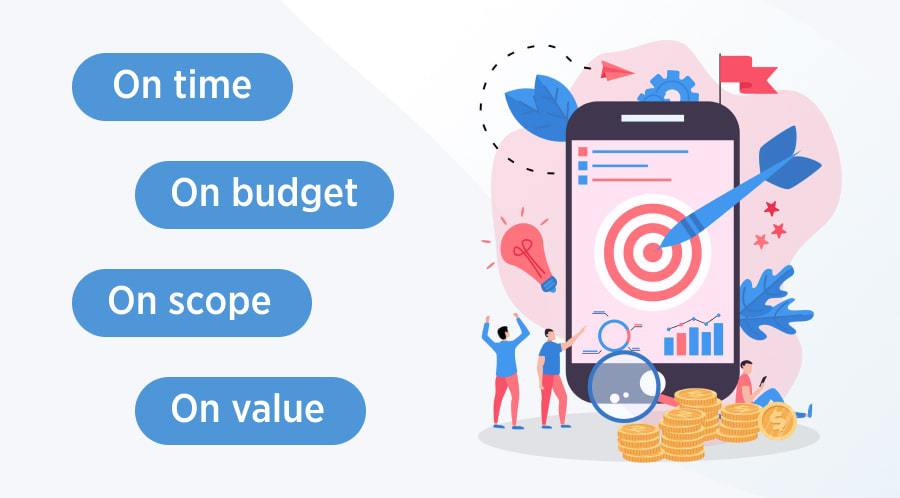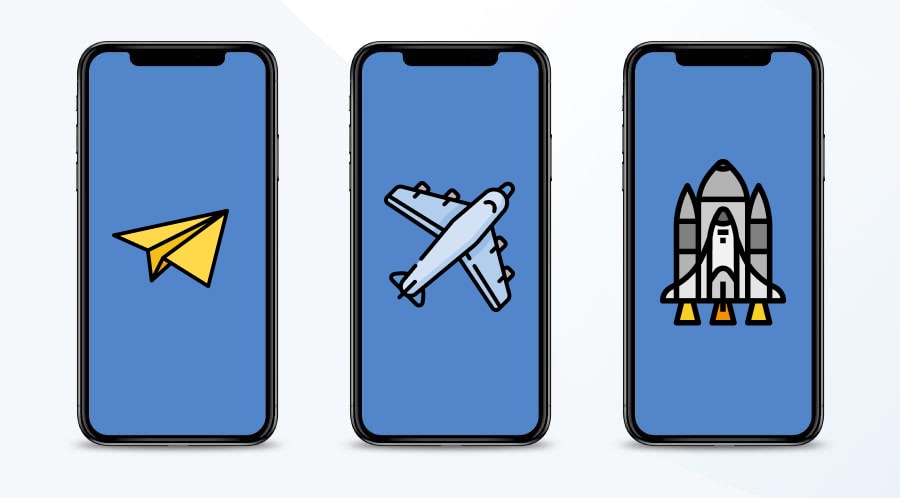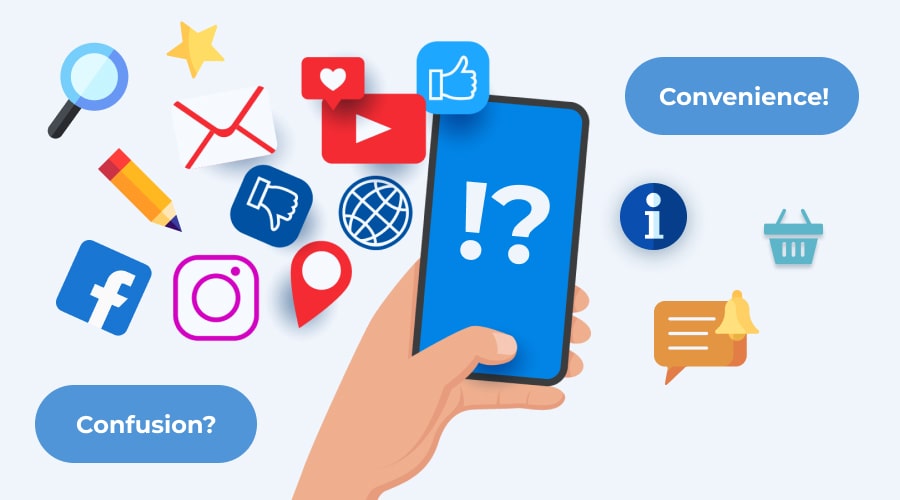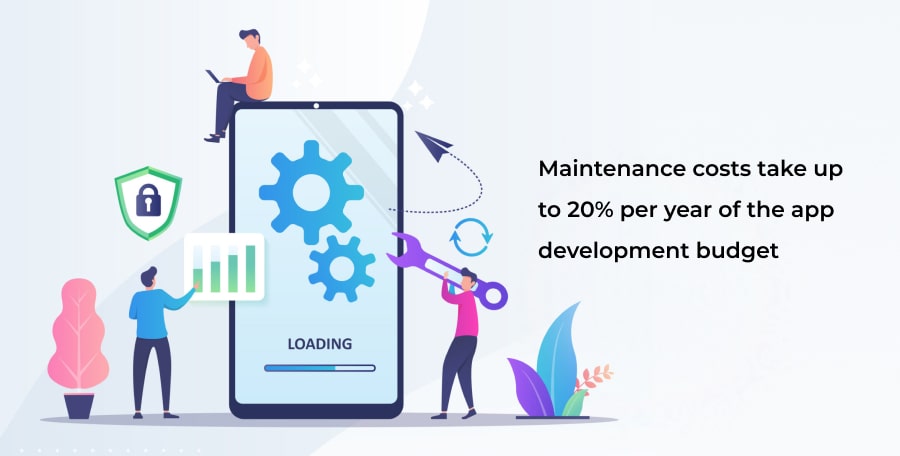Mobile apps are like furniture pieces for mobile devices that become less practical when they lack these valuable parts. And these parts do not necessarily have to be expensive. In this blog post, we will share actionable strategies to build a high-quality mobile app with a limited budget.
“At the birth of the web, companies aimed to get their website bookmarked. Marketers should be in a race to get their apps on the home screen of consumers’ smart devices.”
— Dick Stroud, Managing Director at 20plus30
Mobile apps have become powerful instruments for businesses across all industries. They bring a variety of benefits to the company tables and allow them to enhance customer engagement and loyalty, improve business visibility, and eventually increase profits.
Generally, the process of app development is complex, takes a lot of time and resources. That is why many companies still believe that a product created with a strict budget is bound to fail. However, clear goals, the right strategy, and an experienced mobile development team help companies deliver functional applications within a fixed budget keeping the quality high.
First, you would probably want to know how much it costs to build a mobile app. Well, the average cost of mobile app development varies from $10,000 to $500,000. Not the answer you’ve expected, right? Thus, you need to focus on your app and estimate the investments.
Knowing the ballpark cost to develop your app, you might wonder how to reduce expenses and fit the project into the frames of your budget? These 7 helpful practices below will guide you on how to effectively lower costs without risking the success of the new app.
Project Estimates
Watch our webinar to learn about the practical ways to evaluate your software project estimates.
Top 7 Tips to Build a High-Quality Mobile App with a Limited Budget

1. Set Clear Goals and Reasons for your App
The first and one of the most important steps on the way to staying within a determined budget is proper planning. It would not be wise to underestimate this phase as it sets the keystone for the rest of the project.
If planning is done in haste and with little attention, you may leave out some significant details and overlook key moments. It can lead to additional expenses. That is why it is important to perform business analysis.
Learn more about The Value of Business Analysis for Mobile App Development
When the initial idea of the application comes to light, it is essential to set clear goals and define key outlines that influence not only the cost but also the entire success of the app.
Primarily, you can start with:
- Target audience
- Comparison with competitor products
- A set of fundamental features for your app
- Monetization strategy
There are questions that may help you determine the reasons behind your app. Before diving into the process of development, go through this useful checklist:
- What is the target audience and who is going to use the app?
- What competitor solutions are presented on the market and what unique value your app can offer?
- What issues should the app solve?
- What are the benefits of the app for users?
- When and how will your app be used? What requirements should the app meet in this case?
- What are the basic functions and features the app should include?
- What results are you aiming to achieve in a short- and long-term perspective?
The outline of such an examination should provide a solid ground for the successful mobile app and ensure that non-essential steps and features are excluded. As a result, the company can avoid unforeseen expenses and prevent busting the budget.
User-Driven Approach
Watch our webinar and learn the top ways of reducing poor user satisfaction, low adoption rates, and decreased loyalty.
2. Develop an MVP
When the budget is limited, consider developing a Minimum Viable Product (MVP) instead of rushing into the full-fledged app creation. This approach allows companies to roll out the application with a basic set of features enough for the target audience.

In accordance with the MVP concept, it is better first to define the truncated functionality that will include a few key features. Launching an MVP app will enable collecting users’ feedback, estimating more accurately market demand for the new product, and validating the whole idea with minimum investments.
Read How to Avoid Mistakes and Create a Killer MVP App
Once the app is tested in the real market, it is possible to invest more funds into the full-featured product. Ultimately, MVP eliminates the risk of spending excessive sums in the beginning, saves time and resources, and maximizes ROI.
3. Choose the Right Platform
Reaching out as many users as possible is definitely a good intention. Yet, when it comes to developing a mobile app with a limited budget, it could be discreet to focus on one platform in the beginning. Targeting Android and iOS platforms simultaneously is expensive and more time-consuming; it will hardly help keep development costs down.

The best way to choose an ideal platform for the new application is to conduct target audience research and market analysis. Find out what system the users of the future app prefer and what platform aligns better with your development strategy based on cost-effectiveness.
There are various mobile development approaches that can help you deliver the best product depending on what you need. If, for example, starting with just one platform is beyond your strategy, there is an alternative to go for cross-platform mobile development.
Read the case study on How a Cross-Platform App Allowed The Global Energy Company to Reach Their Audience
Generally, a separate mobile app for each operating system implies better performance. Still, the cross-platform approach allows companies to reach their target audience faster; it simplifies the process and gives life to apps with a unified look and feel across multiple platforms.
Choosing a Winning App Development Strategy
Watch our webinar to uncover effective mobile development approaches and launch your app.
4. Keep it Simple, Intuitive, and Unique
Building a mobile app often comes with a desire to add as many features as possible and deliver the best user experience.
In practice, more features do not necessarily mean better functionality or greater benefits for customers. On the contrary, complex and numerous elements built in the app can confuse users, drastically increase the costs, and extend the process of mobile app development.
Instead of creating a multifunctional and all-encompassing solution, highlight the key characteristics that will help your company stand out from competitors. Include unique and intuitive features and prioritize them following development costs and user needs.

For example, if you are working on the insurance application, such a feature as policy management might be a top priority. The idea is to encourage users to regularly turn to the application and provide them with tools at hand to solve their issues.
In addition to functional simplicity, plain design and hassle-free navigation are extremely valuable for user experience. Clarity is the best guide for users and the key to their satisfaction that, eventually, leads to the support of your app. Moreover, complex infrastructure adds up the cost.
5. Select a Suitable Pricing Model
Another significant factor for consideration when developing a mobile app with a limited budget is the pricing model. Making the right choice about how to pay your outsourcing partner is crucial for the cost-efficiency and overall success of the app development endeavor.
Basically, there are two common pricing models: fixed and hourly. For the right decision to be made, it is essential to understand the difference between these two concepts and what approaches and traits of development each of them offers. In reference to this choice, analyze app requirements and preferences with your development partner.
Choose hourly pricing model:
- If your app is complex and multifunctional
- If you want to gain more control of the process
- If the app idea is not entirely clear and needs to be revised
- If the best suitable project life cycle is iterative
Choose a fixed pricing model:
- If you have a simple and clear idea of the app
- If you need to build an MVP or a prototype
- If your requirements and preferences are clearly defined in advance
- If the budget is crucial
In most scenarios with a tight budget, fixed pricing seems to be the right solution. Nevertheless, pay attention to the fact that this model is less flexible and leaves no opportunities for modifications of the app without extra costs. However, some development companies do not charge any fees in case of minor tweaks or adjustments.
6. Consider Maintenance Costs
As the lifecycle of the app consists not only of the development stage but also of deployment and maintenance, it is provident to keep in mind relevant expenses as part of the budget. For many companies thinking about a new application, such costs are often not expected since they focus on the development phase only.
App maintenance can greatly affect your budget. Thus, knowing how much it will cost to maintain the app in advance will help you plan the app budget precisely.

On average, it is common to take into account approximately 20% of the app development budget per year to maintain software. For instance, if the costs for development are $100,000, then plan to spend around $20,000 for app maintenance accordingly.
App maintenance may include upgrades, bug fixes, small tweaks, and feature improvements. Commonly, your software development vendor provides you with estimates of these activities and suggests how and when you need to update your app.
7. Go for the Right Partnership
Yes, it might sound hackneyed and well-known, but the question of choosing the right partner for developing the app is as weighty as all points mentioned above. The success of the app, its quality, and the chance of staying within the boundaries of your budget very much depend on the development team selected for the project.
There is a great variety of options to build an app nowadays. You can turn to mobile dev shops, freelancers, or full-service development companies.
Expanding a Team
Watch our webinar to unveil the tricks of onboarding a tech partner and incorporating it into the process to foster your product delivery.
When it comes to mobile app development, you definitely need someone you can genuinely rely on, someone with the right set of skills and knowledge. There are many reasons behind hiring an outsourcing company, as well as a vast number of them on the market. So, you might wonder how to choose the right one for your business?
If you ask your potential partner the right questions, you can quickly find out red flags in the answers to watch for and narrow down your choice. Basically, the key factors to pay attention to are:
- Expertise in your industry
- Profound experience in similar projects
- Compelling portfolio
- Project management skills
Look for a company that speaks your language, understands your business goals, and can create a mobile solution aimed to reach success.
Build the App Without Going Broke
Taking into consideration all that has been said above, custom mobile app development can be much less expensive than everyone may think. With the right strategy and approach, you can build a mobile app with a limited budget.
A proper start sets the tone for the entire process. That is why it is so essential to cultivate a clear idea of the future app, understand the strategy behind it, and have precise goals. The right development partner is irreplaceable at this stage and can provide you with meaningful insights to build a great app, not to mention other phases of application life-cycle.
With years of experience in mobile app development, Velvetech will be happy to deliver a high-quality application at a feasible price. Reach out to us today for a consultation. Our team of professionals is ready to support you with any project, no matter how complex it is.













